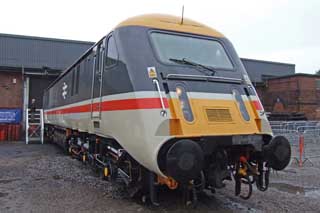The British Rail Class 89 is a prototype electric locomotive. Only one was built, in 1986, by British Rail Engineering Limited's Crewe Works. It was used on test-trains on both the West Coast and East Coast Main Lines. The locomotive was fitted with advanced power control systems and developed more than 6,000 bhp (4,500 kW). After being withdrawn in 1992, it was returned to service in 1996, before being again withdrawn in 2000.
The Class 89 locomotive was designed by Brush Traction, Loughborough to meet a specification issued by British Rail. BR subsequently changed the requirements of this specification, but not before Brush had committed to building the prototype locomotive.
The locomotive had six DC traction motors. The main armature current for all the motors was fed from a common thyristor drive, with each motor having an independent field current controller. The field current controllers comprised a two quadrant chopper inside a thyristor bridge. The bipolar transistor based choppers provided a fast fine control of motor torque for electric braking and slip control, while the thyristor bridge was used to invert the field current polarity.
